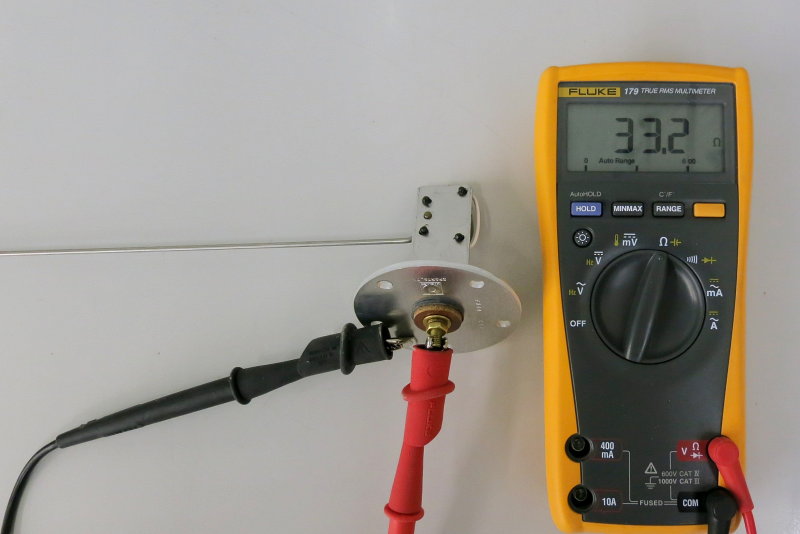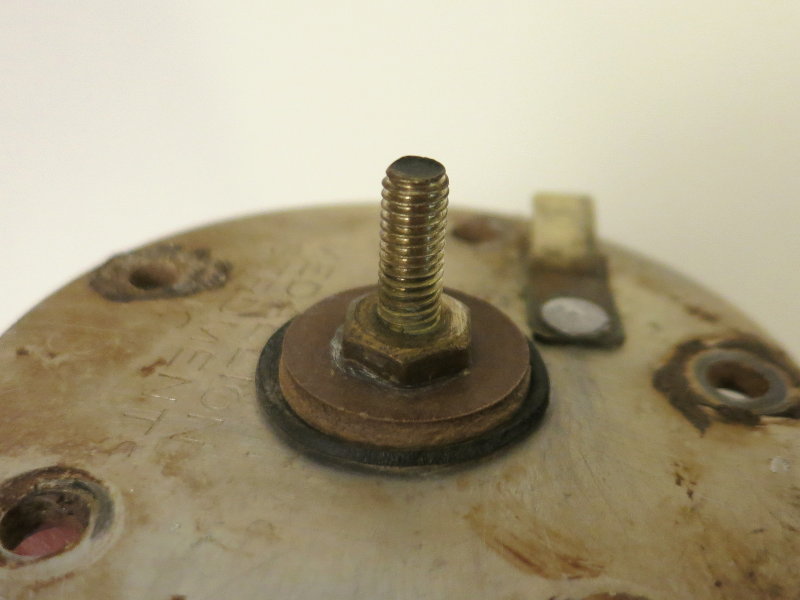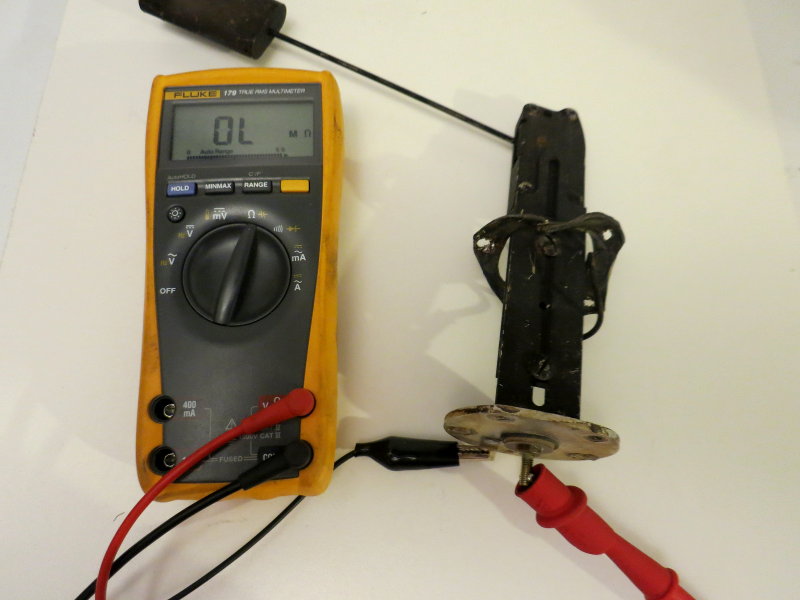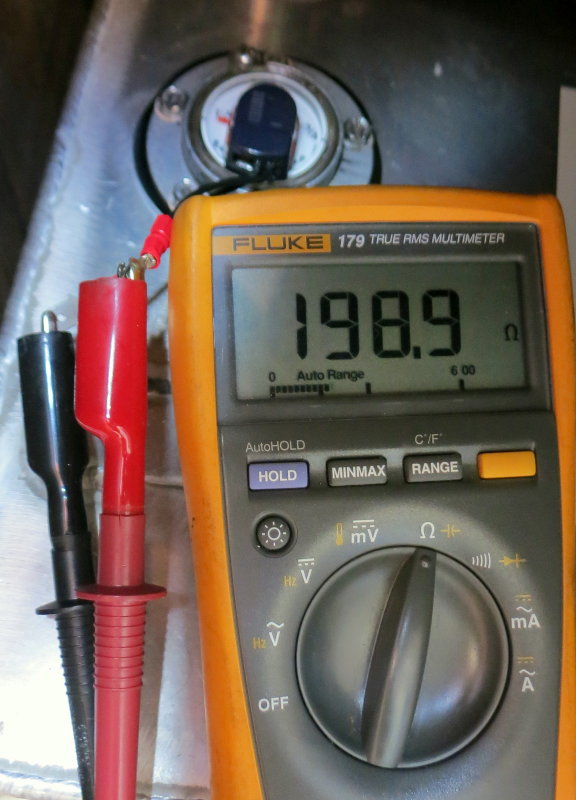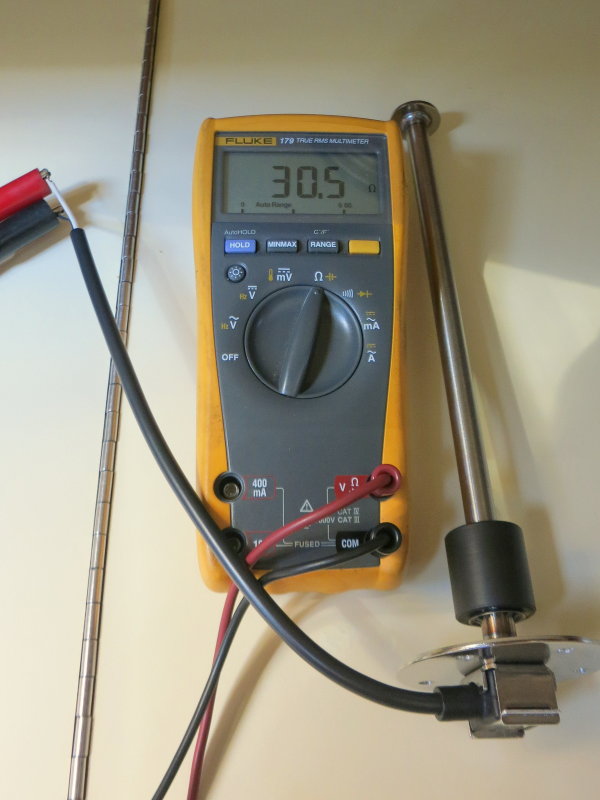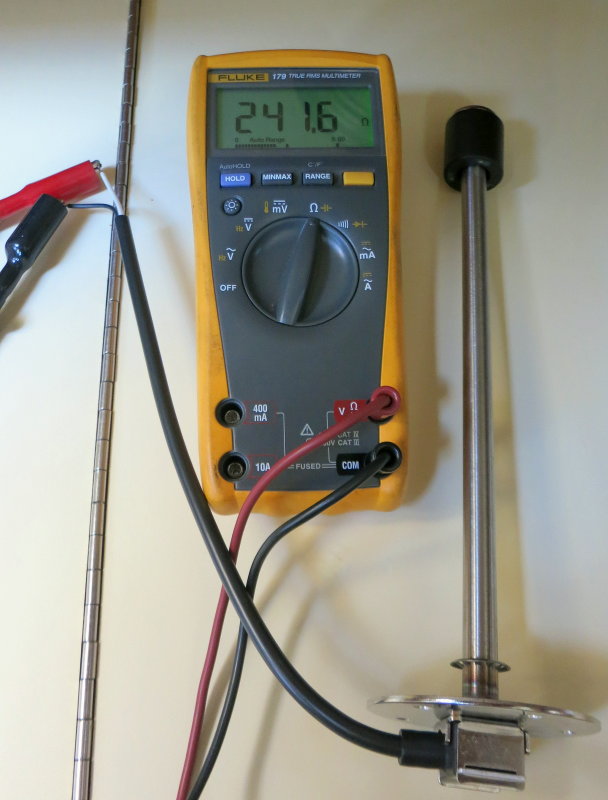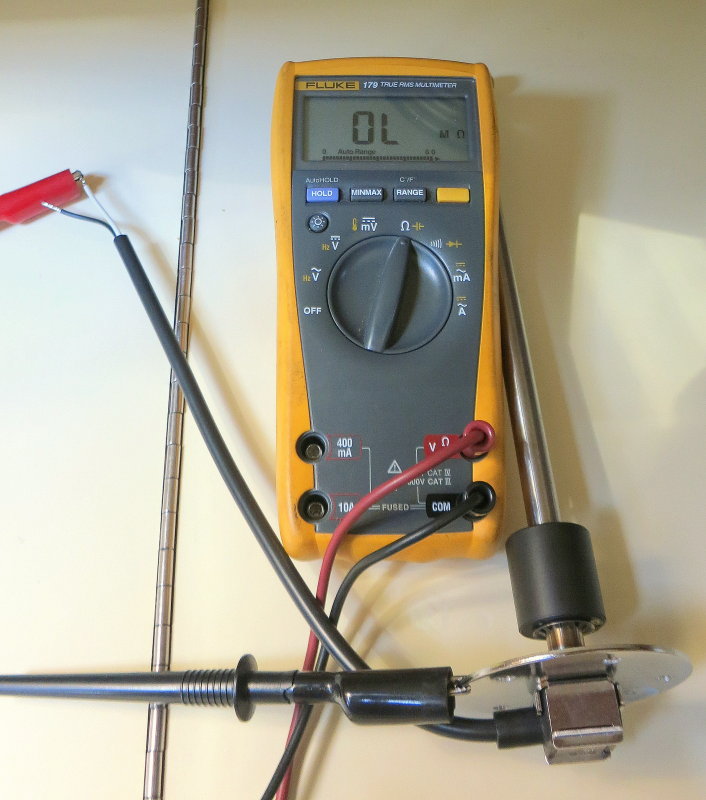Empty – Arm Down = 240 Ohms
The fuel sender, for the typical US standard used in a marine application, is a simple device that presents a resistance reading to the gauge with which it is paired. For US fuel gauges, from the likes of Stewart Warner, Faria, Vee-Three, Moeller, Teleflex, Tempo, Westerbeke, Universal etc. this reading is 33Ω – 240Ω.
In order to test your sending unit simply connect a DVM turned to the Ω setting to the center stud and ground reference. On this particular sending unit, from Moeller, ground reference is the flange or the male Fast On terminal I am connected to.
In this image the tank float arm is vertical or reading empty and we can see a near perfect 237Ω reading. This sender is reading empty just about perfectly.
There are three basic types of fuel sender readily avaible at most marine chandlers.
#1 El Cheapo Type – The one in this photo is the style I refer to as the “El Cheapo”.. They are inexpensive and last just about as long a the flavor of the gum in a pack of baseball cards. I replace this style sender about 10:1 over the other types mentioned below.. If you have one like this, and it has failed, look into the other types shown in this article.
#2 WEMA Type The WEMA sender uses a float that rides up and down a sealed dip tube. No electrical components are inside the tank and exposed to fuel. They are very, very reliable. These senders are sold by WEMA (now KUS), the actual manufacturer, and re-labeled by companies such as Moeller and others.
#3 Mechanical Sender With Electric Conversion Capsule This is one of my personal favorites, It is what I choose on my own vessel. The float is attached to a gear drive which turns a magnet in the head/flange of the unit. There is essentially nothing to fail in these senders and I have yet to see one that has. They are sold first as an unbelievably reliable mechanical sender with visual gauge but with the addition of a “conversion capsule” you have both a mechanical gauge and electric. If the electric gauge should fail you can still read the level of the fuel by looking at the mechanical gauge.
Full – Arm Horizontal = 33 Ohms
In this image the float arm is horizontal to the mounting flange which means the tank would be full. Here we can sea a near perfect full reading of 33Ω.
If your sending unit reads between 33Ω & 240Ω the sender is working properly and you’ll want to investigate the wiring and or the gauge itself.
This is one of the easier tests you can conduct!
NOTE: If you have a European boat or a boat with VDO gauges the resistance readings may be different. Best to check with the gauge manufacturer to see what the input range should be for the sender you are testing.
Clean the Contacts
When testing a used sender it would normally be installed in the fuel tank. The first thing you’ll want to do is clean the center terminal with a brass or stainless steel brush and then clean the ground reference terminal the same way. This will ensure your DVM is getting a good clean contact and no mistaken readings are made.
This one was pretty corroded but is now clean enough for testing.
Test The Sender
This is a prime example of exactly what you don’t want to see. The DVM is reading OL or Open Lead. This means the sender has had a complete failure and has failed open-circuit.
Alternative bad readings would be Ω readings outside the 33Ω to 240Ω range. A little over or under is usually okay but too much over or under represents a bad sender.
This is still an El Cheapo type just a different brand. Note the exposed wires, terminals and such inside the tank.
Mechanical With Conversion Capsule
In this photo we are looking at a Moeller, which used to be Tempo, mechanical fuel sender with an electronic conversion capsule installed. If you look closely you will notice the red pointer of the mechanical gauge pointing to 9:00 or approximately 1/4 of a tank.
The nice thing about these mechanical senders is that regardless of whether the electric fuel gauge is working or not you can still see your fuel level by simply looking at the mechanical gauge. A smart fail-safe design.
To test the conversion electric capsule simply connect the DVM to the two leads coming out of it. Polarity is not important here. This is a perfectly acceptable reading for this sender and it is working correctly.
NOTE: You do not test this type of sender by referencing ground at the flange like you can with the El Cheapo type. The capsule is electrically isolated from the tank.
WEMA Sender – FULL
This is the simple, reliable and easy to install WEMA type sender. There are no electrical components exposed to the fuel inside the tank and the float mechanism is very, very simple.. They are available in just about any depth you could ever want or need but odd depths may need special ordering from your chandler.
For this type of sending unit the DVM is connected to the black and white wires on the pig tail, as shown. You do not reference ground at the flange like you can with the EL Cheapo type. Here the WEMA sender is showing a full reading of 30.5Ω a perfectly acceptable number for full.
WEMA – Improper Test Procedure
Here is why you need to test this sender properly. Note the negative lead for the DVM is connected directly to the flange and we have a OL reading on the DVM. Don’t mistakenly test this type of unit by connecting to the flange. You need to test across the two wires coming out of the top of the sender. Like the conversion capsule this sender is isolated from the tank.
Bottom Line:
What do I recommend and install most?
I prefer the mechanical sender with electronic conversion capsule.
My Favorite:
Moeller Mechanical Fuel Senders
Plus this;
Moeller Conversion Capsule 035760-10
With these two products you now have a visual mechanical gauge plus an electronic sender for any 33-240 Ohm fuel gauge…
Good luck with your own trouble shooting!
Let’s Keep This Site Running!
Like what you saw or read? Would you like to see more articles like this? Is so feel free to donate, support the site and keep it growing. I am trying my hardest to keep this information FREE. If you liked it, learned from it or I saved you some money feel free to make a small donation, that’s all I ask.


